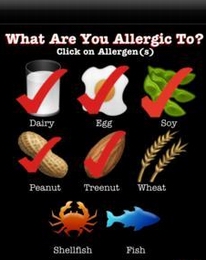 The University of Manchester today kicked off the world’s biggest study on food allergies that will have far-reaching consequences for consumers and food producers. The evidence base and tools that result from the study will support more transparent precautionary “may contain" labeling of allergens in foods which will make life easier for allergy sufferers as they try to avoid problem foods."
The University of Manchester today kicked off the world’s biggest study on food allergies that will have far-reaching consequences for consumers and food producers. The evidence base and tools that result from the study will support more transparent precautionary “may contain" labeling of allergens in foods which will make life easier for allergy sufferers as they try to avoid problem foods."The €9 million project builds on an earlier €14.3 million research study and will involve the world’s leading experts in the United Kingdom, Europe, Australia and the United States. The research project, which is expected to take three years to complete, also will work with groups of babies and groups of children who have been followed from birth in a number of countries to look at allergy and give advice on diet in pregnancy and early life.
Management of both food allergy, by patients and health practitioners, and allergens, by industry, is thwarted by lack of evidence to either prevent food allergy developing or protect adequately those who are already allergic. European Commission-sponsored research, known as the Integrated Approaches to Food Allergen and Allergy Risk Management (iFAAM), will produce a standardized management process for companies involved in food manufacturing. It also will develop tools designed to enforce these regulations and produce evidence-based knowledge to inform new health advice on nutrition for pregnant women, babies and allergy sufferers.
The Manchester team will work with 38 partners including, industrial stakeholders (represented by Unilever and Eurofins), patient groups representing people at risk of severe allergic reactions from Germany, the United Kingdom and Ireland and a risk manager and assessor group including the UK Food Standards Agency. The project will work loosely with the clinical community, working in collaboration with the European Academy of Allergy and Clinical Immunology.
Currently, there is a list of foods considered to be responsible for triggering the majority of allergies across the world that includes milk, egg, peanuts, soya, wheat, tree nuts, mustard, lupin, fish, crustacean and molluscan shellfish and celery that have to be labeled irrespective of the level at which they are included in a recipe. However, management of food allergens that accidently find their way into foods which might otherwise be free of allergen, for example through the use of common processing equipment, remains problematic and often gives rise to precautionary “may contain" labels.
New risk models will be built on pre-existing clinical data sets to support management of these allergens in a factory environment to minimize the use of such labels. Other researchers will look at tools to measure allergens in food to allow validation and monitoring of allergen management plans. Other strands of the project will seek to predict who is likely to suffer a severe reaction, identify whether early introduction of allergenic foods and other nutritional factors may be protective against development of allergies later on in life.
The global food allergy and intolerance products market is projected to exceed $26 billion by 2017, according to a 2011 report from companiesandmarkets.com. The sector’s explosive growth is expected to continue due to increased diagnosis of digestive health conditions, growing interest for wheat-free and gluten-free diets, improved labeling regulations, and tastier and innovations in the category.





